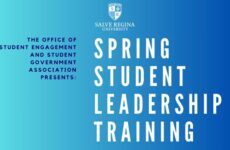By Sofjola Bego | Staff Writer
Environmental friendliness is no longer a new concept to colleges, especially Salve Regina. For a while now, our school has successfully promoted and developed recycling in dorms, less usage of water bottles, and more bike utilization. However, how much effort does it really take to comply with these eco-friendly attempts?
When we want to refill our water bottles at O’Hare, all we have to do is walk less than a minute down the hall and press a button on a near-by fountain. What is even easier, is recycling these bottles; there always seems to be more recycling bins around than trash cans, and some are even available on dormitory floors. Just as easy, is the short amount of time it takes to walk less than five minutes to rent a bike in under 10 minutes. There is no question about it. Salve has made eco-friendly a completely painless idea. The problem is that these are just a few out of the many things our student body should be doing in order to create a healthy atmosphere. The even bigger issue is that even though it is simple to participate in these efforts, some students have yet to get in the habit. No judgment though. The reality is that Salve’s location, and the fact that it is a university, makes it difficult to make every, single part of our lives eco-friendly.
Think about it: some of the biggest habits college students, including Salve students, are always guilty of are not recycling, wasting a lot of energy, driving gas guzzlers, and not buying or using enough organic products.
While Salve has a successful grasp on recycling, it is difficult for students living in such an expensive city to fully break the other habits. This is because Newport is a large tourist attraction throughout the year. In fact, Good Morning America called the town one of the most beautiful places in the country in 2011, and Discover Newport stated that more than 300,000 people visit the town yearly. This means that prices of products, from bus transportation to convenience stores, will naturally be higher than our neighboring communities. Salve’s campus is also voted one of the most beautiful in America by U.S News. So any student that has lived here for a semester or more, and has experienced the countless visitors around them, knows the significant impact the town’s popularity has on our money. For example, Salve does not have a large selection of organic products on campus, but Newport is filled with options. However, the stores’ prices are usually too expensive for a college budget list.
Salve senior, Mackenzie Suter, who enjoys her occasional purchase at A Market, one of Newport’s best organic grocery shops, explains that Salve students would “definitely not pay for organic products, even if they were available on campus.” Understandable, as a small, oh-so-delicious cup of A Market soup costs close to four dollars. That amount does not seem like much, but in this case, a cup of soup, which is hardly a full meal to most people, can amount to 28 dollars a week. If that is budgeted into a Salve student’s other weekly expenses, including more food, gas, rent, and utilities to name just a few, they will start to wonder where their money has disappeared to.
One can argue to shop at Newport’s local supermarkets for organic products, where costs may not be as expensive, but which college student actually has the time to see which of the millions of items are naturally made? This is also the same reason why not using as many appliances, such as clothing dryers, can be unrealistic for Salve students, especially people who play sports. A typical sporting practice at this school will be early in the morning before classes, or in the afternoon, when classes could be held right before or late at night. Michael Mahoney, who has played football for three years at Salve, explains he “constantly needs to wash loads of laundry in order to have a clean uniform for his 6 a.m. practices most week days.” If a student has already had a long day filled with classes and homework, and needs to get a good night’s sleep in order to rest, then taking out their cold, heavy laundry from the machine late at night, or at 4 a.m., and trying to place it on drying racks, one by one, no matter how many loads they have, can become plain unbearable. If Salve’s sporting practices were held at a more convenient time in order for everyone to prepare for them and not use dryers then maybe drying racks could work. Here at Salve though, no one’s schedule is the same for all, and if practice times have not been an issue thus far, then chances are that they are not changing any time soon.
Another unchanging aspect of attending school at Salve is Newport’s harsh winter weather that takes up half of the school year. Suter claims this is “one of the coldest winters” she has experienced during her four years at Salve. This means no student will choose standing outside in the bitter cold, with snow, rain and wind smacking their faces, just to get on a bus. Furthermore, Mahoney does not believe the “bus system in Newport is reliable at all.” There is only one bus that takes students from campus to the main bus station, but it does not pass the main downtown area of Thames Street, where most Salve students live and shop. Also, the streets in Newport are commonly known as historic, meaning they are very small and constantly cause traffic jams. Riding a bus makes the experience worse, as the driver is required to stop to pick up and drop off passengers. Consequently, it does not make life easy for Salve students to travel by bus, especially one bus that takes double the time to get to a location than a car would. If that does not make a Salve student’s day harder, then just add thousands of tourists into the mix.













